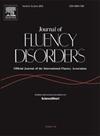成人口吃患病率II:重新计算,分组和估计口吃社区参与。
IF 2.1
3区 医学
Q1 AUDIOLOGY & SPEECH-LANGUAGE PATHOLOGY
引用次数: 0
摘要
目的:口吃的流行病学研究经常集中在儿童身上,相对缺乏针对成年人的人口水平数据。这里重新评估了成人的患病率数据,包括口吃是显性的还是隐性的,以及是在儿童期还是成年期发病。对口吃者参与口吃社区的成年人也进行了估计。方法:患病率计算基于具有最强设计的研究数据,遵循gatti, Lieven & Kluk(2024年,本期)的系统综述。参与口吃社区的原始数据来自英语互联网口吃支持团体,英国的一个国家口吃慈善机构和英国曼彻斯特的一个地区口吃支持团体。结果:成人口吃患病率估计为0.96% (95% CI 0.65, 1.44)。这可以分解为0.63%的显性口吃(95% CI 0.46, 0.79),包括0.53%的儿童发病和0.10%的成人发病;隐性口吃占0.33% (95% CI 0.19, 0.58),其中儿童发病0.28%,成人发病0.05%。隐蔽性口吃可能被高估了,而且通常可能非常轻微。据估计,与口吃社区的接触在国际上为0.99%,在全国为0.63%,在区域为1.01%。由于人员流失和重复计数,实际用户粘性会降低。结论:成人口吃患病率估计值0.96%与广泛引用的各年龄段口吃患病率估计值1%一致。在口吃的成年人中,只有不到1%的人参加口吃社区。本文章由计算机程序翻译,如有差异,请以英文原文为准。
Adult stuttering prevalence II: Recalculation, subgrouping and estimate of stuttering community engagement
Purpose
Epidemiological research of stuttering has frequently focused on children, with a relative paucity of population level data specific to adults. Prevalence data for adults are reassessed here, including a breakdown of whether stuttering is overt or covert, and whether onset was in childhood or adulthood. The engagement of adults who stutter with stuttering communities is also estimated.
Methods
Prevalence calculations were based on data from studies having the strongest designs, following the systematic review of Gattie, Lieven & Kluk (2024, this issue). Original data for engagement with stuttering communities were gathered from English language internet stuttering support groups, a national stuttering charity in the UK and a regional stuttering support group in Manchester, UK.
Results
Adult stuttering prevalence was estimated at 0.96% (95% CI 0.65, 1.44). This can be broken down to 0.63% overt stuttering (95% CI 0.46, 0.79) comprising 0.53% childhood onset and 0.10% adult onset; and 0.33% covert stuttering (95% CI 0.19, 0.58) comprising 0.28% childhood onset and 0.05% adult onset. Covert stuttering will have been overestimated, and may often be very mild. Engagement with stuttering communities was estimated at 0.99% internationally, 0.63% nationally and 1.01% regionally. Actual engagement will have been lower due to attrition and overcounting.
Conclusion
The adult stuttering prevalence estimate of 0.96% is consistent with the widely-cited all ages stuttering prevalence estimate of 1%. Of adults who stutter, fewer than 1% engage with stuttering communities.
求助全文
通过发布文献求助,成功后即可免费获取论文全文。
去求助
来源期刊

Journal of Fluency Disorders
AUDIOLOGY & SPEECH-LANGUAGE PATHOLOGY-REHABILITATION
CiteScore
3.70
自引率
14.30%
发文量
23
审稿时长
>12 weeks
期刊介绍:
Journal of Fluency Disorders provides comprehensive coverage of clinical, experimental, and theoretical aspects of stuttering, including the latest remediation techniques. As the official journal of the International Fluency Association, the journal features full-length research and clinical reports; methodological, theoretical and philosophical articles; reviews; short communications and much more – all readily accessible and tailored to the needs of the professional.
 求助内容:
求助内容: 应助结果提醒方式:
应助结果提醒方式:


